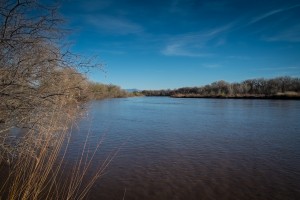update: The preliminary human-in-the-loop forecast is substantially better than the automated one, at 55 percent. But still terrible.
previously: The preliminary Rio Grande forecast for April 1 is just 33 percent of the 1981-2000 average, a dramatic reduction since the March 1 forecast that shows just how abysmally warm and dry the month of March was here in New Mexico and the headwaters regions of Colorado to our north.
The forecast point here is Otowi, between Santa Fe and Los Alamos, which is the point at which the river enters the center of the state. The forecast is very preliminary, based on the automated computer model forecasts. The human-in-the-loop forecast should be out any day, but it’s not likely to be terribly different.

The Rio Grande through Albuquerque has been high recently, because what snow we have is melting early
Flow out of Colorado has already likely peaked, I’m told. It usually doesn’t peak until May. There is some hope for a second peak as water melts out of the Sangre de Cristo’s, the southern Rocky Mountain chain extending from Taos down to Santa Fe. If that happens, water managers may be able to add some stored water for a pulse flow for the endangered Rio Grande silvery minnow, to encourage spawning. Maybe.
The fish and the environment will have the toughest year. The municipal users will be fine. Albuquerque has stored water in Abiquiu Reservoir from previous years, and incredible conservation success (down to 134 gallons per person per day compared to something like 250 20 years ago) means demand is far less. And Albuquerque has groundwater to fall back on.
Farmers in the Middle Rio Grande will have a tougher year, with little storage to fall back on.
The environment will have the toughest time. When there’s no water, there’s no water.
